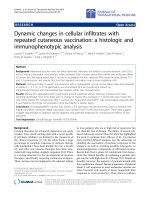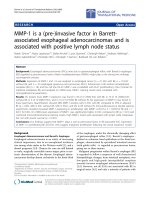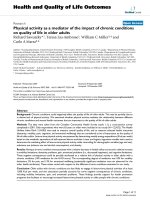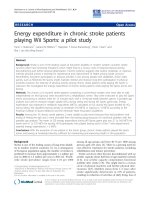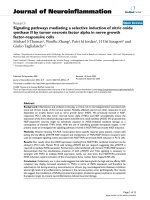báo cáo hóa học:" Initiating Antiretrovirals in a Resource-Constrained Setting: Does One Size Fit All?" docx
Bạn đang xem bản rút gọn của tài liệu. Xem và tải ngay bản đầy đủ của tài liệu tại đây (177.01 KB, 2 trang )
BioMed Central
Page 1 of 2
(page number not for citation purposes)
Journal of the International AIDS Society
Open Access
Commentary
Initiating Antiretrovirals in a Resource-Constrained Setting: Does
One Size Fit All?
Ajay Wanchu
Address: Department of Internal Medicine, Postgraduate Institute of Medical Education and Research, Chandigarh, India
Email: Ajay Wanchu -
Introduction
The World Health Organization (WHO) aims to provide
antiretroviral therapy (ART) to at least 3 million patients
in resource-limited settings by the end of 2005, an initia-
tive referred to as "3 by 5." The program uses a CD4+ cell
count of 200 cells/microliter (mcL) for initiating treat-
ment as a cutoff in asymptomatic individuals.[1] Some
issues need to be addressed when applying the program in
resource-constrained countries such as India.
Limitations of WHO-Recommended Regimen Applied in
India
Reduction in viral load might reduce transmission of
HIV.[2] The combination of drugs primarily used in the
WHO-approved regimen are nevirapine, lamivudine, and
stavudine. This is the cheapest generic formulation in
India that has the advantage of combining all 3 drugs in 1
pill. The cost of this combination is less than $1 per day.
However, in the free treatment program, the number of
patients who would require these medications worldwide
will increase rapidly. Worldwide, 16,000 individuals get
infected daily and each would, sooner, rather than later,
require ART. In India, all of the 5 million-plus patients
would be candidates for treatment. Do we have resources
to provide medication even at less than $1 per day?
It is notable that although nevirapine-based regimens
have been shown to do as well as other regimens, the drug
has never been the "most preferred" in most international
guidelines.[3] The other issue is one of resistance with
nevirapine, as a single amino acid substitution in the
reverse transcriptase gene can result in resistance to the
whole nonnucleoside reverse transcriptase inhibitor
(NNRTI) class of drugs.[4] Once resistance develops the
transmissibility of the virus decreases, but what are the
options for those who develop resistance? In most
instances, anyone who develops resistance today has few
options because alternative regimens are far too costly.
Because no baseline nevirapine resistance rates in treat-
ment-naive patients are available in India, there is no
knowledge about the percentage of individuals who are
unlikely to respond to the ART offered by the 3 by 5 initi-
ative in the first instance.
Can Treatment Be Deferred?
Are we treating patients when they can do without ART?
Can we defer treatment in asymptomatic patients? Per-
haps we can. Western cutoffs to initiate ART may not be
appropriate, as some studies have shown lower CD4+ cell
counts in apparently healthy Indians. In one study, the
range of CD4+ cell counts in healthy Indians started from
just over 300 cells/mcL.[5] Another study carried out in
200 healthy Indians showed that CD4+ cell counts ranged
between 304 and 1864 cells/mcL.[6] A modest decline
early in the course of disease might qualify the patient for
initiation of ART. Can we wait longer until "chronic
immune failure" develops, as early initiation means that
patients lose their only therapeutic option much faster?
Another issue relates to pitfalls in using guidelines where
CD4+ cell counts decide treatment. Does one size fit all?
Thus, while cytomegalovirus (CMV) infection develops
most often with CD4+ cell counts < 50 cells/mcL, does
everyone with a CD4+ cell count < 50 cells/mcL develop
CMV disease? Surely no. Do we, then, treat everyone on
the basis of a CD4+ cell count that tells us that an individ-
ual with CD4+ cell count < 200 cells/mcL is at heightened
risk for opportunistic infections (OIs), even though a frac-
tion do not develop OIs?
Published: 8 August 2005
Journal of the International AIDS Society 2005, 7:67
This article is available from: />Publish with BioMed Central and every
scientist can read your work free of charge
"BioMed Central will be the most significant development for
disseminating the results of biomedical research in our lifetime."
Sir Paul Nurse, Cancer Research UK
Your research papers will be:
available free of charge to the entire biomedical community
peer reviewed and published immediately upon acceptance
cited in PubMed and archived on PubMed Central
yours — you keep the copyright
Submit your manuscript here:
/>BioMedcentral
Journal of the International AIDS Society 2005, 7:67 />Page 2 of 2
(page number not for citation purposes)
The crucial issue is: Are we treating patients in resource-
constrained settings far too early and running the risk of
exhausting their therapeutic options much earlier rather
than starting therapy later and providing a longer survival
on the same regimen and resources? It could be argued
that deferring therapy for too long would compromise the
patient's ability to recover pathogen-specific immune
responses. However, is a patient with advanced immuno-
suppression with a CD4+ cell count of 175 cells/mcL, but
free of OI, an ideal candidate to initiate ART when all he
has by way of therapeutic options is the first regimen that
the WHO provides? Perhaps no. Therapeutic options in
the underprivileged begin and end with the first and only
regimen. In addition, early treatment would result in ear-
lier resistance to nevirapine. Can we use the available
agents more judiciously to prolong survival? If not every-
one with a CD4+ cell count < 200 cells/mcL develops OI,
should everyone then be made to take ART when we do
not know the risk of developing OIs in a given individual?
Current Status and Short-term Needs
The recent WHO report that provides an update on the 3
by 5 program should provide food for thought to policy
makers regarding the financial implications of providing
treatment under the program:
The estimate of approximately 1 million people now on
treatment falls short of the milestone of 1.6 million set in
the WHO/UNAIDS "3 by 5" strategy for June 2005. Cur-
rent data and trends indicate that providing ART to 3 mil-
lion people by the end of 2005 will be unlikely. However,
there is reason to be hopeful that growth rates will con-
tinue to increase in the remainder of 2005 and beyond.
Although less than what is needed, an estimated US$27
billion are available or have been pledged for HIV/AIDS
globally from all sources for the three-year period
20052007. UNAIDS estimates that at least an additional
US$18 billion above what is currently pledged is needed
for global HIV/AIDS efforts over the next three years,
including treatment, care and prevention. Donors should
continue to increase their financial commitments, and
work with countries to develop long-term funding
arrangements that assure sustained and predictable sup-
port.[7]
Like several countries, including India, the WHO is also
resource-constrained. Under these circumstances, will sec-
ond-line agents be a realistic option, even though each
one of the 5 million-plus patients in India (plus those in
the rest of the developing world) would become candi-
dates for these, sooner or later (sooner, rather than later,
if we initiate treatment early)?
Summary and Conclusion
We must look for alternative mechanisms that can iden-
tify individuals at greater risk of developing an OI. At a
bare minimum, we must reconsider the 200 cells/mcL
CD4+ cell count cutoff for initiating ART among those
who are asymptomatic.
Authors and Disclosures
Ajay Wanchu, MD, DM, has disclosed no relevant finan-
cial relationships.
References
1. World Health Organization: The 3 by 5 initiative. [http://
www.who.int/3by5/en/]. Accessed July 29, 2005
2. Quinn TC, Wawer MJ, Sewankambo N, et al.: Viral load and heter-
osexual transmission of human immunodeficiency virus type
1. N Engl J Med 2000, 342:921-929. Abstract
3. Ivers LC, Kendrick D, Doucette K: Efficacy of antiretroviral ther-
apy programs in resource-poor settings: a meta-analysis of
the published literature efficacy of antiretroviral therapy
programs in resource-poor settings: a meta-analysis of the
published literature. Clin Infect Dis 2005, 41:217-224. Abstract
4. Calvez V, Delaugerre C, Rohban R, et al.: Resistance profile and
cross-resistance of HIV-1 among 102 patients failing a non-
nucleoside reverse transcriptase-inhibitor based regimen.
Antiviral Ther 2000, 5(suppl 3):97-103.
5. Nag VL, Agarwal P, Venkatesh V, Rastogi P, Tandon R, Agrawal SK: A
pilot study on observations on CD4 & CD8 counts in healthy
HIV seronegative individuals. Indian J Med Res 2002, 116:45-49.
Abstract
6. Amatya R, Vajpayee M, Kaushik S, Kanswal S, Pandey RM, Seth P:
Lymphocyte immunophenotype reference ranges in healthy
Indian adults: implications for management of HIV/AIDS in
India. Clin Immunol 2004, 112:290-295. Abstract
7. World Health Organization: Progress on Global Access to HIV
Antiretroviral Therapy: An update on 3 by 5. 2005 [http://
www.who.int/3by5/fullreportJune2005.pdf]. Accessed July 29, 2005


